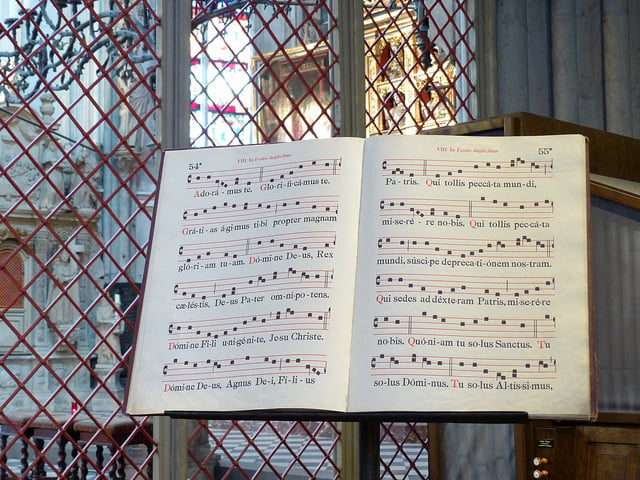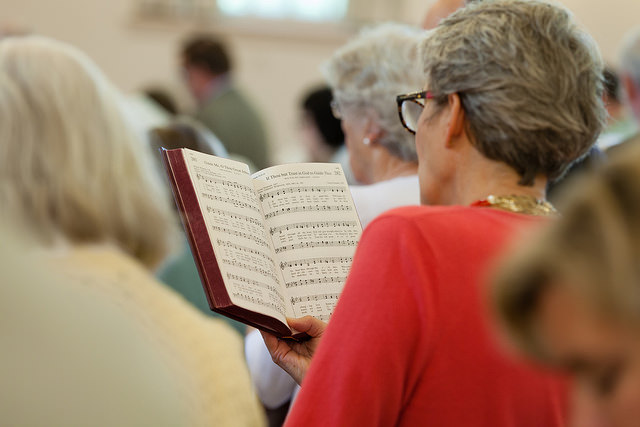http://www.youtube.com/watch?v=NnIqTjl8aGw
Opening Sentences
I think now it’s easier to write worship songs which are basically like teenage love songs, and there’s a lot of worship songs which are basically about me and Jesus falling in love. That’s fine, but as I’ve often said to teenagers, the point of falling in love is it’s like striking a match, which is a very exciting thing to do, in order then to light a candle with it. A candle is not as initially exciting, but actually it’s a very beautiful thing, and if you look after it, it will last a whole lot longer. And so, what I want to see is Christians trying to develop music styles which grow out of and have the excitement of contemporary music, but are always looking for something which will sustain, something which will last. And for me, and I’m a traditionalist in this sense, I grew up singing the good old fashioned hymns in the 1950s and 60s, and still, if I’m walking down the street or going to sleep at night, I’m very happy to have those great old hymns in my head, and I worry that a lot of stuff that’s written at the moment isn’t going to last five minutes in anyone’s head, and mightn’t do them that much good if it did. -N.T. Wright
Offering Our Congregations “Good” Songs
There are a few people who, when they speak about corporate worship in the church, I stop and listen. N.T. Wright is one of those people, not because I always agree with him, but because his voice is always one of reason, objectivity, and thoughtfulness. Listening to these words, I can’t help but challenge current ideas about the function of church music. I keep returning to the question “When does a congregational song do us good?” Obviously, for church music to do us good, it has to be good. And while the question of what is “good” could easily lead us into an argument of preference, or taste, an argument which nobody will ever win, we have to discipline ourselves to look deeper into what we do as congregations and as church musicians to question the meaning behind what we do, all the while not allowing ourselves to answer with, “Because it makes me feel good.” So, while we’re on the subject, what makes a song “good?”
Theory, Theology, Doxology
A song is good when it lights candles. A song makes a difference when it helps the truth of the Gospel take root in ourselves and our congregations, and sustains us as a beautiful church in an ugly world.
There is an obvious undertone in many worship songs that glorifies the initial spark of a relationship, to borrow a lyric from Old Blue Eyes himself, the “sudden explosion when two tingles intermingle.” And I’m not just talking about “Jesus is my girlfriend” songs, in which Jesus could be anyone who turns us on. Even if it’s clear in the text that the other person in the relationship is Jesus himself, if the lyrics don’t point beyond how good Jesus is for my disposition, it doesn’t give us much to sustain through every season of life.
There’s a lot of this kind of crap on the CCLI charts, but it’s not a recent trend. Here’s an example from my good old 1975 Baptist Hymnal.
There’s really not much here of substance. I mean, it’s okay if Jesus makes us feel good, but the gospel isn’t about rewarding us with good vibes and posh cosmic accommodations. It probably struck a match in many a big tent revival, but it doesn’t light a candle. It doesn’t deepen. It doesn’t convict. It doesn’t tell God’s story. It doesn’t sustain. We can do better.
A song is good when it is theological. Like Wright says, it’s not always easy to write texts that say something substantial about the character of God and the beauty of Christ’s renewing work in the world, but it’s an ultimate necessity for Christian worship. That’s not to say that every song must be an in-depth theological treatise, but I think we should ask questions like:
Do we actually believe this?
Does this tell God’s story? Does this serve the liturgy?
A song is good when it is musical. As a musician, I have to bring this point into the discussion. Even though the text of congregational songs must be the first concern, it must be paired with “good” (There’s that word again!) music. A fantastic text with a crappy tune pairing can be so distracting that there’s hardly any point in doing it. For instance, though I appreciate the intentions of those who have resurrected old, obscure hymn texts by pairing them with new tunes, unfortunately, the finished products are often unmusical.
Here’s an example from the folks over at Indelible Grace.
It’s a good text for a reformed congregation. But the music, *sigh*, the syncopation and syllabification is confusing and unpredictable. The meter changes are unnecessary. And if I submitted this melody to Dr. Millar in my freshman theory class, it probably would have come back with the word “noodly” written in giant red script all over it. The proclamation is lost as we’re hunting and pecking at the rhythm and melody. We might as well not even sing at all.
A song is good when it stretches us beyond our current space and time. We need the words of those who have gone before to wash the modern glaze out of our eyes and bring their witness into our vocabulary. We should bring the Psalter back into our gathered worship. We recite early creeds. We use chant. Our congregational songs are selected from different streams of hymnody. For those of us who select songs for worship week in and week out, it’s easy to fall into a rut. One safeguard I use is to not choose two pieces of music from the same century, whether hymns, anthems, instrumental, or otherwise. In some places this might not be possible, but our congregations need the chance to sing a broad range of Christian experience. Jesus wasn’t born last night. It’s time our worship began to reflect that fact. Additionally, there’s something wrong if we’re not singing new music, and that includes traditional congregations. The contemporary worship phenomenon has taught us that traditional means “old.” It’s old songs for old people. That is a toxic, morbid presumption. Just as we incorporate the best from previous generations, we allow the best new music to inspire, enable, and broaden our perspective. 
A song is good when it elicits a thoughtful and heartfelt congregational response. There’s an article going around right now by Todd Pruitt called “Is Your Church Worship More Pagan than Christian?” He raises some good points about whether it’s appropriate to rely on music to bring us into God’s presence. There is much in it that could be discussed, but he raises a helpful point: worship services have become all about creating an emotional experience for people. And if musicians can’t “strike the match” every week, they soon face uncertain job security.
When this is the case, I think we’re expecting too much out of music.
Occasionally, I will get a comment like, “Great worship today” or “That music really helped me worship.” I try to be polite while I cringe inside. I don’t want the music to be so noticeable. I want it to be a vehicle for God’s story to be told, not to be a false indicator of authentic personal worship. If there’s a positive emotional response for worshipers, fine, but that’s not the goal. All music chosen must have a specific function that is dictated by the liturgy. When we allow music out of this rightful place, we run the risk of making it a narcissistic, self-referential, and ultimately meaningless exercise.
A Well-Tempered Benediction
Corporate worship isn’t about creating an experience, and neither is congregational singing.
It’s about working together, proclaiming to our Creator who he is and what he has done. It’s about reminding ourselves who Christ is and who we are in him, and readying ourselves for another week in the business of being Kingdom people. It’s about preparing for our eternal role in the heavenly choir. It’s about caring for the flame burning inside of us, instead of fumbling with the matches, hoping for yet another meager spark.












